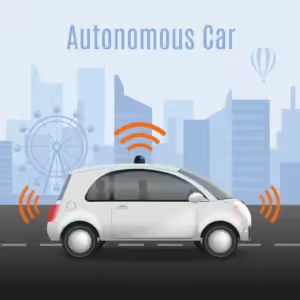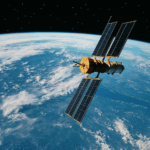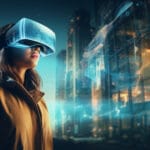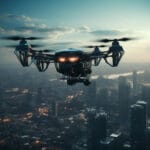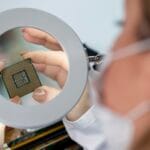Autonomous vehicles, commonly referred to as self-driving automobiles, are a game-changing advancement in the transportation industry. These cars have the power to completely transform the way we use our roads, bringing with them promises of improved security, lessened gridlock, and greater global mobility. Their intricate interplay between perception and decision-making processes is at the core of how they work.
Self-driving cars can comprehend their environment, make snap decisions, and travel safely thanks to these systems. However, this procedure presents considerable processing difficulties due to the sheer amount and complexity of data involved. In order to speed up autonomous vehicles’ vision and decision-making, Field-Programmable Gate Arrays (FPGAs) come into play.
In this article, we will delve into the critical role of FPGAs in self-driving cars, exploring how they contribute to the realization of safer and more efficient autonomous transportation systems.
Perception of Self-Driving Cars
The fundamental sense of perception is what enables self-driving cars to comprehend and engage with their surroundings. Perception in the context of autonomous cars entails gathering and analyzing information from numerous sensors to provide a precise and accurate representation of the environment. This illustration has details on other cars, people walking down the street, the state of the roads, traffic lights, and more. Real-time reliable perception must be achieved in order for self-driving automobiles to function safely and effectively.
A. Understanding Perception in Autonomous Vehicles
Self-driving cars use a variety of sensors to gather information about their environment, including LiDAR (Light Detection and Ranging), radar, cameras, and ultrasonic sensors. LiDAR sensors send out laser pulses and track how long it takes for the pulses to bounce off of various objects, producing precise 3D images of the surroundings. Radio waves are used by radar sensors to identify the presence and motion of objects. Cameras record visual data, and ultrasonic sensors gauge an object’s proximity. Together, these sensors offer a complete picture of the area around the car.
Sensors and Data Collection
Self-driving cars’ sensors continuously gather information from their surroundings, producing enormous volumes of data every second. One LiDAR sensor, for instance, is capable of producing millions of data points each second. High-resolution images are captured by cameras, and nearby objects’ velocities and distances are reported by radar sensors.
Data Preprocessing and Fusion
Sensor data must be preprocessed after collection in order to reduce noise, account for sensor errors, and synchronize data from several sensors. The input from numerous sensors is combined using data fusion techniques to produce a comprehensive and coherent representation of the environment. The ensuing stages of perception and decision-making depend on this combined input.
B. Challenges in Real-Time Perception
Achieving real-time perception in dynamic and unpredictable environments presents several challenges for self-driving cars:
Environmental Variability: Roads and traffic conditions can vary widely, from clear sunny days to heavy rain, fog, or snow. Self-driving cars must be able to perceive their environment accurately under diverse conditions.
Sensor Noise and Inaccuracies: Sensors may produce erroneous data due to sensor noise, occlusions (objects blocking the view of others), or sensor degradation over time. Ensuring the reliability of perception systems is critical for safety.
C. FPGA’s Role in Accelerating Perception
Field-Programmable Gate Arrays (FPGAs) have emerged as a powerful solution to accelerate perception in self-driving cars:
Parallel Processing Capabilities: FPGAs are highly parallelizable, meaning they can perform multiple computations simultaneously. This parallelism is well-suited to the data-intensive nature of sensor data processing.
Low-Latency Data Processing: FPGAs can process sensor data with ultra-low latency, allowing self-driving cars to react quickly to changing conditions. This low-latency processing is essential for real-time perception.
FPGAs enable self-driving cars to handle the immense data streams from sensors efficiently and effectively. They process sensor data in parallel, ensuring timely and accurate perception, even in challenging and dynamic environments. The utilization of FPGAs in perception systems significantly contributes to the safe and reliable operation of autonomous vehicles.
Decision-Making in Self-Driving Cars
The cognitive foundation of self-driving cars is decision-making, where intricate algorithms and in-the-moment data processing decide how the vehicle should move, react to impediments, and interact with its surroundings. Processing sensor data, comprehending the road environment, devising a safe route, and managing the vehicle’s motions are all necessary components of autonomous driving.
In this section, we examine the complexities of autonomous vehicle decision-making, the difficulties it poses, and the contribution of Field-Programmable Gate Arrays (FPGAs) to its acceleration and improvement.
A. The Importance of Rapid and Accurate Decision-Making
In autonomous vehicles, decision-making must be both swift and precise. Delays or errors in decision-making can lead to accidents or hinder the smooth flow of traffic. Key aspects of decision-making include:
Sensor Data Interpretation: The analysis and interpretation of sensor data, including object detection and tracking, are crucial for understanding the dynamic environment around the vehicle.
Object Detection and Tracking: Identifying and tracking objects such as vehicles, pedestrians, and cyclists are fundamental for collision avoidance and safe navigation.
Path Planning: Deciding the vehicle’s route and trajectory while considering traffic rules, obstacles, and other road users.
Control Signals Generation: Generating control commands for the vehicle’s actuators (e.g., steering, acceleration, and braking) to execute the planned path safely.
B. Components of Autonomous Decision-Making
To accomplish the tasks mentioned above, autonomous decision-making systems are composed of several interrelated components:
Sensor Data Fusion: Combining data from various sensors to create a comprehensive understanding of the environment. For instance, combining LiDAR, radar, and camera data helps build a more complete perception of the surroundings.
Perception Algorithms: Advanced algorithms process sensor data to identify objects, estimate their positions and velocities, and classify them (e.g., identifying a pedestrian versus a car).
Localization: Determining the precise position of the vehicle in its environment, often using techniques like GPS and inertial navigation.
Mapping: Creating detailed maps of the environment, which assist in route planning and vehicle positioning.
Path Planning Algorithms: These algorithms generate a safe and efficient path for the vehicle, taking into account dynamic obstacles, traffic rules, and user preferences.
Control Algorithms: Converting the planned path into control commands for the vehicle’s actuators, ensuring smooth and safe execution.
C. Challenges in Real-Time Decision-Making
Autonomous decision-making poses several challenges, including:
Safety Considerations: Ensuring the safety of passengers and other road users is paramount. Decision-making systems must incorporate redundancy, fail-safe mechanisms, and robust error handling.
Computational Complexity: Processing and analyzing vast amounts of sensor data in real time requires immense computational power. Ensuring efficient and timely decision-making is a significant challenge.
D. FPGA’s Role in Accelerating Decision-Making
FPGAs play a pivotal role in addressing the computational demands of real-time decision-making in self-driving cars:
Hardware Acceleration for Algorithms: FPGAs can be programmed to accelerate specific algorithms used in perception and decision-making, offloading the main processor and reducing latency.
Predictive Modeling with FPGAs: FPGAs can efficiently handle predictive modeling tasks, such as anticipating the movements of other vehicles or pedestrians, contributing to safer decision-making.
The Role of FPGAs in Self-Driving Car Hardware
Field-Programmable Gate Arrays (FPGAs) are integral to the hardware architecture of self-driving cars, as they offer a unique combination of versatility and performance for addressing the demanding computational requirements of autonomous vehicles. In this section, we delve into the role of FPGAs in self-driving car hardware, highlighting their capabilities, applications, and the advantages they bring to this cutting-edge field.
A. Understanding Field-Programmable Gate Arrays (FPGAs)
FPGAs are semiconductor devices that can be reprogrammed to perform various functions, making them highly adaptable to specific tasks and applications. They consist of an array of configurable logic blocks and programmable interconnects, which can be customized to implement complex digital circuits.
Definition and Basic Architecture: FPGAs comprise a matrix of programmable logic gates and memory elements. These gates can be configured and connected to perform a wide range of digital operations.
FPGA Programming and Reconfigurability: FPGAs are programmed using hardware description languages (HDLs) such as Verilog or VHDL. Their reconfigurable nature allows for flexibility in adapting to evolving software and hardware requirements.
B. FPGA Applications in Self-Driving Car Hardware
FPGAs find multiple applications within the hardware architecture of self-driving cars, playing a pivotal role in enhancing safety, performance, and efficiency:
Custom Hardware Accelerators: FPGAs can be customized to accelerate specific algorithms and computations critical for perception and decision-making. For instance, they can accelerate complex neural network operations, significantly speeding up object recognition and tracking.
Redundancy and Fail-Safe Mechanisms: Safety is paramount in autonomous vehicles. FPGAs can be used to implement redundant systems that monitor critical functions, providing a layer of safety redundancy. In case of a hardware or software failure, FPGAs can take over to ensure safe vehicle operation.
Sensor Data Preprocessing: FPGAs can preprocess sensor data directly at the hardware level, reducing the computational load on the main processing unit (CPU or GPU). This preprocessing includes data filtering, noise reduction, and initial feature extraction.
C. Advantages and Limitations of FPGAs in Self-Driving Car Hardware
While FPGAs offer numerous advantages, they also have certain limitations within the context of self-driving cars:
Advantages:
- Parallel Processing: FPGAs excel at parallel processing, enabling them to handle the massive amounts of data generated by sensors concurrently and in real time.
- Low Latency: The inherently low latency of FPGA-based processing ensures rapid decision-making and response, crucial for safe autonomous driving.
- Customizability: FPGAs can be tailored to the specific needs of a self-driving car’s hardware, allowing for the optimization of critical algorithms and functions.
- Energy Efficiency: FPGAs can provide efficient hardware acceleration, reducing power consumption compared to traditional CPUs or GPUs.
Limitations:
- Development Complexity: Designing and programming FPGAs require specialized knowledge and tools, which can increase development complexity.
- Limited Resources: FPGAs have finite resources in terms of logic gates, memory, and I/O pins. Designing complex systems may require careful resource management.
- Initial Costs: FPGAs and associated development tools can be expensive, adding to the initial cost of building self-driving car hardware.
Challenges and Future Directions
While Field-Programmable Gate Arrays (FPGAs) hold immense promise in advancing self-driving car technology, their integration into autonomous vehicles is not without challenges. Moreover, as the self-driving car industry evolves, there are intriguing future directions where FPGAs can play an even more significant role.
A. Current Challenges in Integrating FPGAs in Self-Driving Cars
Hardware Complexity: FPGA-based system development calls for particular skills and knowledge, which raises the complexity and cost of the process. Simplifying FPGA integration and programming is essential as demand for autonomous vehicles rises.
Safety and Certification: Ensuring the safety and certification of FPGA-based systems in self-driving cars is a paramount concern. Rigorous testing and verification processes are necessary to meet safety standards and gain regulatory approval.
Scalability: Self-driving car hardware must be scalable to accommodate evolving computational demands. FPGAs need to adapt to changing requirements without significant hardware changes, a challenge that demands robust hardware and software architectures.
B. The Role of Artificial Intelligence and Machine Learning
The future of FPGAs in self-driving cars is closely intertwined with the advancement of artificial intelligence (AI) and machine learning (ML) technologies:
AI-Driven Perception: FPGAs can accelerate AI algorithms used in perception systems, such as neural networks for object recognition. As AI continues to evolve, FPGAs can keep pace by providing efficient hardware acceleration.
Reinforcement Learning: Reinforcement learning, a subset of machine learning, has the potential to enhance decision-making in self-driving cars. FPGA-based hardware accelerators can facilitate real-time learning and adaptation.
Data-Intensive Tasks: With the proliferation of sensor data and the need for data-driven decision-making, FPGAs can become even more vital in handling data-intensive tasks efficiently.
C. Regulatory and Safety Considerations
As self-driving cars become a common sight on our roads, regulatory frameworks and safety considerations will play a significant role in shaping the future of FPGAs in autonomous vehicles:
Safety Standards: Regulatory bodies will establish and refine safety standards for autonomous vehicles, including the use of FPGAs. Compliance with these standards will be crucial for widespread adoption.
Ethical and Liability Issues: The self-driving car industry will face ethical dilemmas and questions of liability. FPGAs will need to operate within frameworks that address these ethical concerns and determine responsibility in the event of accidents or failures.
D. Future Trends and Advancements in FPGA Technology
The future of FPGAs in self-driving cars holds several exciting possibilities:
Advanced Hardware Platforms: FPGA manufacturers will likely develop more powerful and efficient FPGA platforms tailored to the unique requirements of self-driving cars.
Standardization: Efforts to standardize FPGA programming and integration processes may simplify their adoption in the automotive industry.
Edge Computing: FPGAs are well-suited for edge computing, and their role in processing data closer to the source (e.g., on the vehicle itself) will likely expand.
Conclusion
A ground-breaking innovation that has the potential to transform transportation is the incorporation of Field-Programmable Gate Arrays (FPGAs) into the world of self-driving cars. FPGAs are essential in accelerating vision and decision-making, which helps self-driving cars negotiate challenging surroundings quickly and accurately. These flexible hardware accelerators provide a vital balance of performance and agility, making them crucial for addressing the challenging computing requirements of autonomous driving.
The road to mainstream adoption is still fraught with obstacles, despite the potential. Continuous innovation and strict standards are necessary to guarantee the safety, certification, and scalability of FPGA-based systems. To accommodate this developing technology, regulatory frameworks must change, and autonomous vehicle-related ethical issues must be carefully considered.
However, there is a lot of potential for FPGAs in self-driving cars, especially as machine learning and artificial intelligence develop. FPGAs will be crucial in advancing data-driven technologies and opening the door for a time when autonomous vehicles are more common, safer, and efficient on our roads. The development of autonomous vehicles heralds a transformative period in innovation, one in which the nexus of technology and mobility transforms how we relate to the outside world.


![What is FPGA Introduction to FPGA Basics [2023] computer-chip-dark-background-with-word-intel-it](https://fpgainsights.com/wp-content/uploads/2023/06/computer-chip-dark-background-with-word-intel-it-300x171.jpg)

